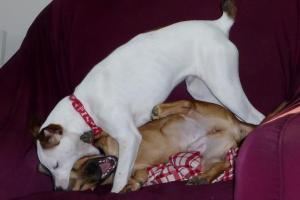How Do I Know if My Dogs are Fighting or Exhibiting Normal Play Behavior?
- posted: Aug. 20, 2017
 Are They Playing or Fighting?
Are They Playing or Fighting?
Dogs frequently exhibit exuberant and noisy play. But how do you tell if growling and sparring is more than just play and when should you intervene to prevent things from escalating into a nasty dog fight?
Normal play typically includes pouncing, jumping, chasing and what is known as a “play bow” where the dog has his rear end in the air and paws and front legs down on the ground. The dogs engaged in play should also have “soft” faces with relaxed features and open mouths. The dogs may growl or bark at one another during normal play and may nip or snap at one another, but should not cause any physical harm. Biting, growling and sparring can look and sound quite intense, so watch the dogs’ body language for clues if things are getting out of hand. Furrowed brows, tense postures and facial features (growling with a closed mouth, ears pinned back, etc.) or raised hair along the neck or back (raised hackles) all indicate aggression rather than relaxed play.
Dogs engaged in play should play at the level of the weakest dog in the group such as when a larger dog displays submissive behaviors or more gentle play with a smaller dog. Play should also end when one dog disengages. Relentless pursuit of a dog who is no longer interested in the game is not normal. There are no “winners” when groups of dogs play, so role reversal is also common during normal play. In other words, the dog being chased initially will then turn and chase his opponent.
If dogs are not practicing role reversal, are engaged in tense, relentless, aggressive play including grabbing and shaking another dog, or one dog relentlessly pursues another without stop, this is concerning. If the dogs are stiffly stalking one another with little to no vocalization this could also indicate aggressive behavior rather than play behavior. If you witness any of these signs, it is time to intervene. Clap your hands, make a loud noise or call your dog away. Be cautious with any attempt to physically remove the dogs or intervene unless you are sure you can safely do so, especially if you do not know the dogs. Aggression and dog fights can escalate and occur quickly. Don’t get between dogs who are behaving in this manner.
Play among dogs is normal and healthy, and, while often boisterous, it is generally safe. But, keep a close eye on dogs at play and try to distract them and halt the play if they seem to be getting too intense.
This blog brought to you by the Patton Veterinary Hospital serving Red Lion, York and the surrounding communities.
Source www.dvm360.com
Location
Patton Veterinary Hospital
425 E Broadway
Red Lion, PA 17356
